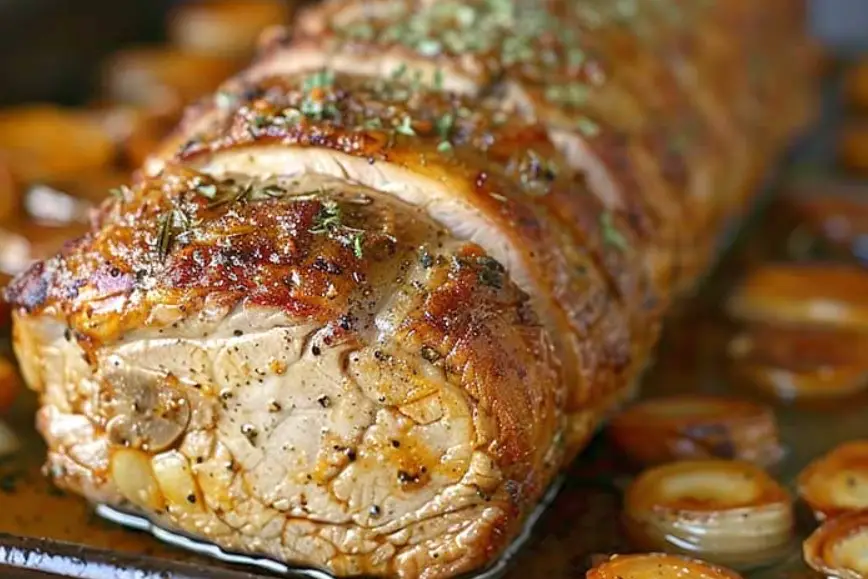Serving Tips:
- Slicing Technique: When serving the pork loin roast, use a sharp carving knife to slice it against the grain into thick, uniform pieces. This helps maintain the tenderness and juiciness of the meat and ensures each slice is easy to cut and enjoy.
- Garnishes: Enhance the presentation of the pork loin roast by garnishing it with fresh herbs such as parsley, thyme, or rosemary. Sprinkle some chopped herbs over the sliced meat or place a few whole sprigs on the serving platter for an elegant touch.
- Accompaniments: Pair the pork loin roast with complementary side dishes to create a well-rounded meal. Classic accompaniments include roasted vegetables like carrots, potatoes, and Brussels sprouts, as well as creamy mashed potatoes or buttered noodles. Don’t forget to serve with a flavorful sauce made from the pan drippings for added depth of flavor.
- Family-style Presentation: For a casual dining experience, place the whole roasted pork loin on a large serving platter and let your guests carve their own slices at the table. This interactive approach adds an element of fun and allows everyone to choose their preferred portion size.
- Keep it Warm: To keep the pork loin roast warm while serving, cover it loosely with aluminum foil and place it in a preheated oven set to the lowest temperature. Alternatively, use a chafing dish or warming tray to maintain the temperature until ready to serve.
Storage Tips:
- Refrigeration: After the pork loin roast has cooled to room temperature, transfer any leftover portions to an airtight container or wrap them tightly in aluminum foil. Store in the refrigerator for up to 3-4 days.
- Freezing: If you have a large amount of leftover pork loin roast that you won’t be able to consume within a few days, consider freezing it for later use. Wrap individual portions tightly in plastic wrap or aluminum foil, then place them in a freezer-safe bag or container. Properly stored, frozen pork loin roast can last for up to 2-3 months in the freezer.
- Reheating: When ready to enjoy leftover pork loin roast, reheat it gently to prevent drying out the meat. Place the slices in a baking dish, cover with foil, and warm in a preheated oven at around 325°F until heated through. You can also reheat individual slices in the microwave, using short intervals to avoid overcooking.
- Creative Uses for Leftovers: Don’t let leftover pork loin roast go to waste! Use it to make sandwiches, wraps, salads, or hearty soups. The tender and flavorful meat can also be diced and added to pasta dishes or stir-fries for a quick and satisfying meal option.
- Safety Precautions: Always practice proper food safety guidelines when storing and reheating leftover pork loin roast. Thaw frozen leftovers in the refrigerator overnight before reheating, and ensure that all reheated portions reach an internal temperature of 165°F to ensure they are safe to consume.
FAQs:
1. How long does it take to cook a pork loin roast? The cooking time for a pork loin roast depends on several factors, including the size of the roast, the oven temperature, and whether it’s bone-in or boneless. As a general guideline, a boneless pork loin roast typically takes around 20-25 minutes per pound at 350°F to reach an internal temperature of 145°F to 160°F, which is considered safe for consumption.
2. Can I marinate the pork loin roast before cooking? Yes, marinating the pork loin roast before cooking can add flavor and moisture to the meat. You can use a variety of marinades, such as a mixture of olive oil, herbs, garlic, citrus juice, and spices, to infuse the pork with delicious flavors. Marinate the pork loin roast in the refrigerator for at least 4 hours, or preferably overnight, for the best results.
3. How do I know when the pork loin roast is done cooking? The best way to determine if a pork loin roast is done cooking is by using a meat thermometer. Insert the thermometer into the thickest part of the roast, away from any bones, and ensure it reaches an internal temperature of 145°F to 160°F. Additionally, the meat should be firm to the touch, and the juices should run clear when pierced with a knife.
4. Should I cover the pork loin roast while cooking? While it’s not necessary to cover the pork loin roast while cooking, some chefs prefer to cover it loosely with aluminum foil for the first part of the cooking process to prevent the exterior from becoming too dark or drying out. You can remove the foil during the last 30 minutes of cooking to allow the exterior to brown and develop a delicious crust.
5. How do I carve a pork loin roast? To carve a pork loin roast, start by placing the roast on a cutting board and locating the bone (if bone-in). Use a sharp carving knife to slice perpendicular to the bone, cutting thin slices against the grain. If the roast is boneless, simply slice it crosswise into thick, uniform pieces. Be sure to carve against the grain to ensure tender slices of meat.

